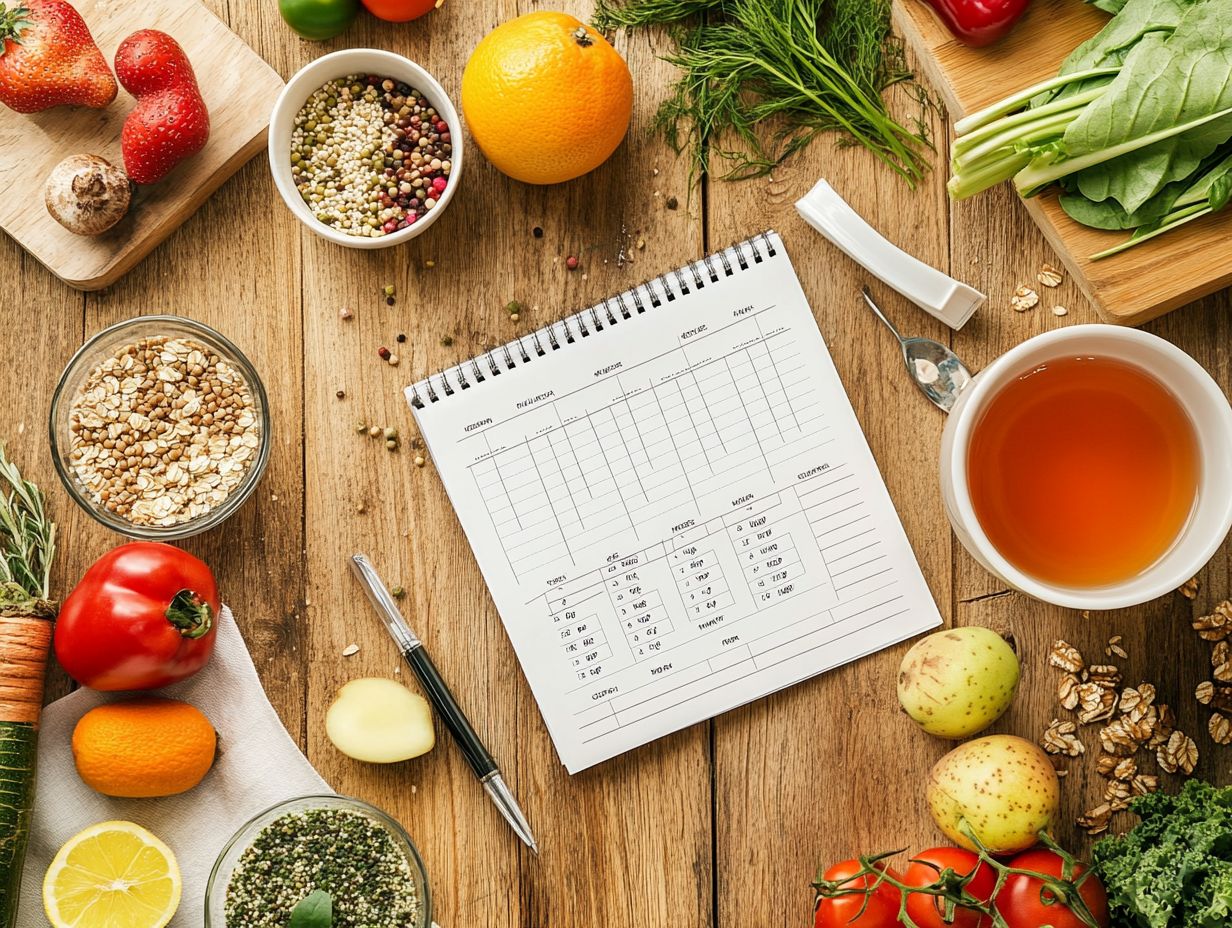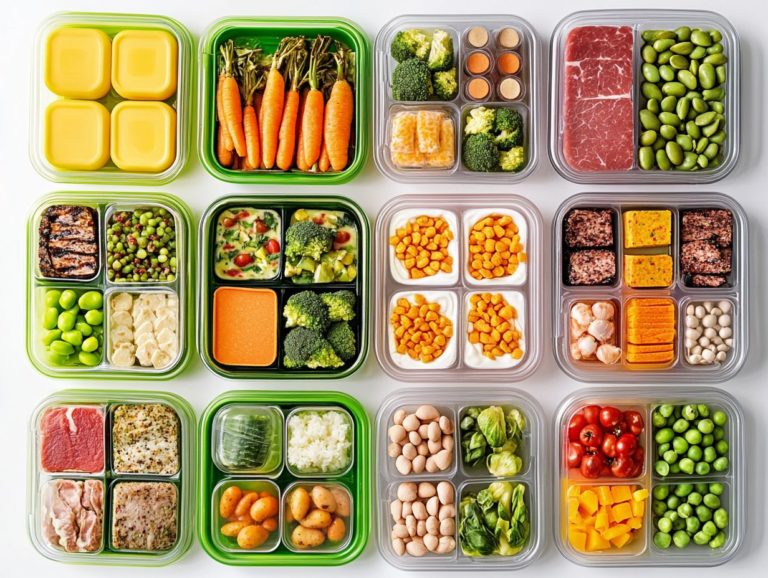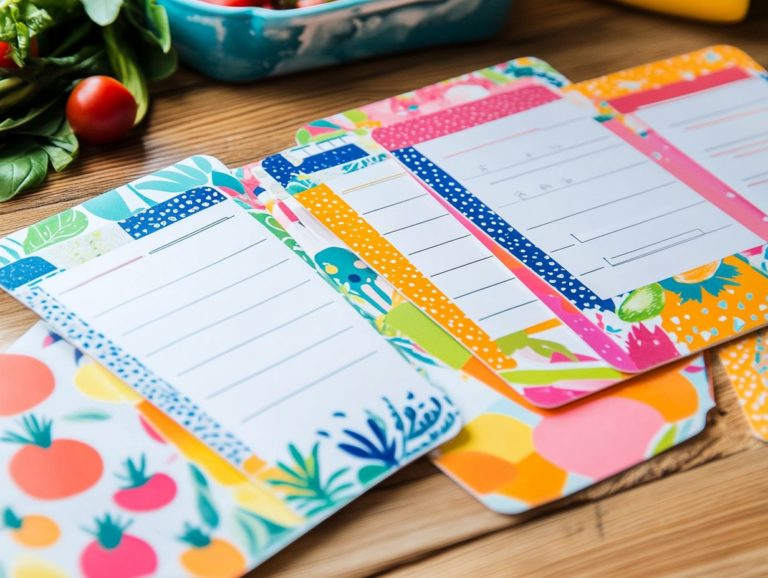How to Create a Weekly Meal Plan That Works
Meal planning is not just a trend. It s a transformative approach for your health and finances.
By carefully planning your meals, you can enjoy nutritious choices while managing your grocery budget. This article will guide you through the basics of meal planning. You’ll start by setting a budget and checking your kitchen inventory. Then, you’ll learn how to choose recipes and prepare meals ahead of time.
You will discover strategies to add variety to your meals and use your leftovers effectively. Plus, we ll provide sample meal plans for different dietary needs.
Dive in now! It s time to elevate your mealtime routine!
Contents
- Key Takeaways:
- The Importance of Meal Planning
- Step-by-Step Guide to Creating a Weekly Meal Plan
- Tips for Successful Meal Planning
- Healthy and Budget-Friendly Meal Ideas
- Frequently Asked Questions
- What are the benefits of creating a weekly meal plan?
- How do I start creating a weekly meal plan?
- How often should I change my weekly meal plan?
- How can I make sure my weekly meal plan is balanced and nutritious?
- What are some tips for sticking to a weekly meal plan?
- Can I still have flexibility in my weekly meal plan?
Key Takeaways:

Meal planning has many benefits for both health and budget. It reduces food waste and saves time and money on grocery shopping.
Create a weekly meal plan by setting a budget, taking inventory of your kitchen, choosing recipes, and prepping meals in advance.
Successful meal planning means using leftovers, incorporating variety, and exploring healthy, budget-friendly meal ideas for different dietary needs. For more tips, check out this guide on how to plan meals around your schedule.
The Importance of Meal Planning
Meal planning helps you and your family make healthier food choices while managing your budget and minimizing waste.
By crafting a weekly meal plan, you gain control over your grocery shopping, ensuring fresh ingredients are available. This approach, guided by the best practices for weekly meal planning, considers your family’s food preferences and cooking skills, enabling everyone to enjoy delicious, home-cooked meals that meet various dietary needs.
Meal planning also simplifies your cooking schedule. By implementing the best meal planning strategies for beginners, you can focus your energy and time on creating nourishing recipes, free from the stress of last-minute decisions.
Benefits for Health and Budget
The benefits of meal planning significantly enhance your health and budget management.
By organizing your meals in advance, you access a variety of nutritious recipes that fit seamlessly into your routine. This proactive strategy curbs the temptation to order takeout and fosters healthier eating habits rich in whole foods.
When you take the time to make a detailed grocery list based on your meal plan, sticking to a budget becomes easy. This practice saves you money and reduces food waste, ensuring every ingredient is used efficiently.
Step-by-Step Guide to Creating a Weekly Meal Plan
Creating a weekly meal plan requires a thoughtful approach that enhances your cooking skills while streamlining meal prep.
By following these methodical steps, you can choose recipes that cater to your family’s tastes and nutritional goals, improving your grocery shopping experience.
This organized strategy minimizes waste and allows you to repurpose leftovers in innovative ways throughout the week.
1. Set a Budget and Time Frame
Setting a budget and timeframe is the first step to successful meal planning. It guides your choices and keeps you within financial limits.
Assess your family’s dietary needs and preferences to create a grocery list that reflects what everyone enjoys and needs for optimal health. Being mindful of varying tastes and dietary restrictions enhances meals and helps reduce waste.
Time management strategies can streamline meal preparation. Allocate specific days for grocery shopping and meal prep to notice a significant difference.
As you schedule these activities, consider how often your family gathers around the table. Plan meals that cater to those occasions, balancing budgeting with time efficiency.
2. Take Inventory of Your Kitchen

Taking inventory of your kitchen is an essential step in meal planning. It involves checking your pantry and freezer to identify available ingredients and minimize food waste.
By understanding what items you have on hand, you can make informed decisions when selecting recipes. This ensures that you prepare meals with what s readily available instead of scrambling for last-minute grocery runs.
To streamline this process, maintain a detailed list of pantry staples, perishables, and frozen goods. Update it regularly as you use or replenish items.
Using effective storage solutions, like clear containers and labeled shelves, enhances visibility and accessibility, creating a more organized kitchen.
This awareness reduces the likelihood of forgetting ingredients and sparks creativity, allowing you to find unique ways to utilize what you already possess.
3. Choose Recipes and Make a Grocery List
Choosing recipes that resonate with your family’s food preferences is an enjoyable part of meal planning. This allows you to craft a grocery list that aligns perfectly with your culinary inspirations.
Consider the dietary needs and diverse cooking skills in your household. Explore a variety of recipes that cater to everyone, including vegetarian or gluten-free options.
Involve family members in the recipe selection process to foster inclusion. This makes it easier to integrate beloved dishes that everyone adores.
Maintaining a list of simple, go-to recipes can streamline your cooking efforts, ensuring that less experienced chefs in your family feel confident and comfortable.
By blending family favorites with fresh ideas, you can develop a well-rounded meal plan that sparks enthusiasm and participation around the dinner table!
4. Prep and Cook Meals in Advance
Meal prep and cooking in advance are smart strategies to save time and elevate your efficiency. Enjoy fresh, home-cooked meals throughout the week while alleviating the stress of daily cooking.
Embrace methods like bulk cooking, which means preparing a large amount of food at once, and discover creative ways to repurpose ingredients from previous meals.
Set aside dedicated time for meal preparation to enhance your organization and encourage a healthier lifestyle.
This proactive approach keeps your meals varied and exciting while minimizing food waste. Transform leftovers into delightful new dishes, enabling you to navigate your culinary experiences with greater ease.
Tips for Successful Meal Planning
Successful meal planning relies on essential tips that emphasize flexibility and creativity.
Make your cooking fun and stress-free while effectively managing your grocery list and budget!
Make Use of Leftovers
Utilizing leftovers is a smart meal planning tip that saves money and minimizes food waste. Transform what might end up in the trash into delicious new dishes!
Turn yesterday’s roasted vegetables into a hearty frittata or mash leftover potatoes into flavorful pancakes. Properly sealing items can significantly extend their lifespan, keeping them fresh for repurposing.
Mastering these skills elevates your everyday ingredients and opens a realm of innovative meal possibilities.
For instance, leftover grilled chicken can be reimagined in a vibrant salad or tucked into a savory wrap, showcasing the versatility that comes with thoughtful meal planning.
Include Variety and Flexibility

Including variety and flexibility in your meal planning is crucial for keeping family dinners exciting and accommodating diverse food preferences. It maximizes seasonal sales and fresh ingredients.
One effective strategy is to incorporate different cooking methods such as grilling, roasting, steaming, and slow cooking into your weeknight menus. This elevates flavors and allows you to adapt based on time constraints or unexpected changes in your schedule.
For example, if plans suddenly shift, a slow-cooked stew can be easily prepared in advance, while a quick stir-fry can save the day on busier nights. Embrace seasonal themes or explore cultural cuisines to ignite your creativity. Get ready to tantalize your taste buds by experimenting with new recipes!
With this adaptable approach, you can create an engaging and diverse meal experience without the stress.
Healthy and Budget-Friendly Meal Ideas
Healthy and budget-friendly meal ideas serve as the foundation of effective meal planning, and learning how to overcome meal planning challenges can help you create delectable options that nourish your family without straining your finances.
Sample Meal Plans for Different Dietary Needs
Creating sample meal plans for various dietary needs is a brilliant way to highlight the versatility and inclusivity of effective meal planning, like how to meal plan for a family of four. This ensures that everyone in your family feels catered to.
Imagine a vegetarian meal plan filled with hearty vegetable stir-fries and protein-packed lentil salads. For gluten-free options, think quinoa bowls and baked sweet potatoes that are both delicious and satisfying. Low-carb choices could feature zoodles tossed in vibrant pesto paired with refreshing grilled chicken salads.
By emphasizing a diverse range of recipes, you keep mealtime exciting and make it easier to incorporate important nutrients that cater to the varied preferences of each family member.
These tailored meal plans bridge the gap between maintaining beloved family favorites and encouraging healthier eating habits. They ultimately create a supportive and inclusive kitchen environment.
Frequently Asked Questions
What are the benefits of creating a weekly meal plan?
There are several benefits, including:
- Saving time and money
- Eating healthier
- Reducing food waste
How do I start creating a weekly meal plan?

The first step is to make a list of your favorite meals and ingredients. This helps you come up with ideas for planning a week of healthy meals.
How often should I change my weekly meal plan?
It is recommended to change your weekly meal plan every week. This allows for variety in your meals and prevents boredom with your food choices. For tips on this, check out how to make a meal plan that fits your lifestyle.
How can I make sure my weekly meal plan is balanced and nutritious?
Include a variety of food groups such as fruits, vegetables, whole grains, lean proteins, and healthy fats. This ensures your meals are balanced and provide all the necessary nutrients.
What are some tips for sticking to a weekly meal plan?
To stick to your meal plan:
- Prep your meals and snacks in advance
- Make a grocery list and stick to it
- Choose recipes that are easy and quick to make
Can I still have flexibility in my weekly meal plan?
Absolutely! It’s important to be flexible and make adjustments as needed. If unexpected events arise or ingredients go bad, don’t hesitate to modify your plan. Having a general structure while allowing for flexibility is key.
Start planning your meals today to enjoy delicious, stress-free dinners!





